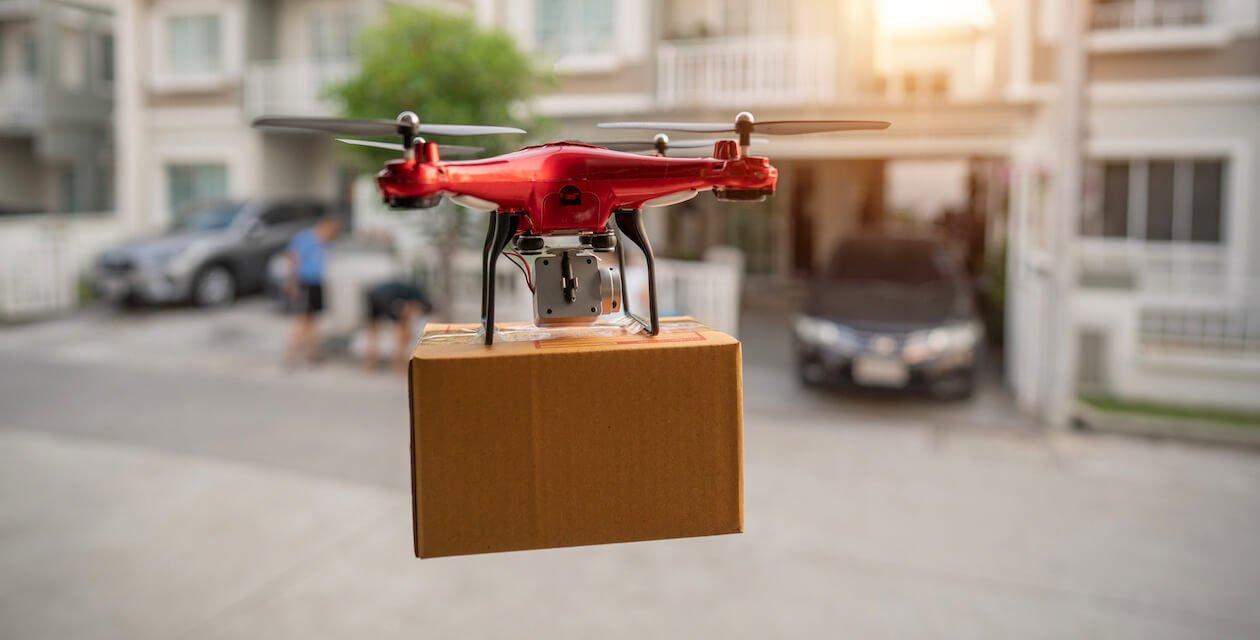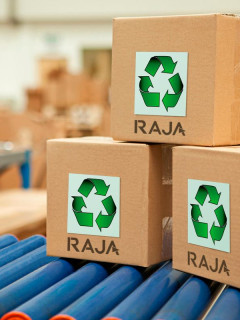So imagine the scene: a drone picks up the order your operators have just prepared from your warehouse and takes off to land directly on the customer’s doorstep.
This is not a science fiction movie: this drone delivery technology is already a reality, and promises to revolutionise your future shipments.
What if tomorrow you could offer your customers, in addition to express delivery in a point-relais, in a depository or at home, delivery by drone? Find out here where this innovative shipping method stands, its advantages and its limits.

Delivery by drone: a reality far from science fiction
An innovation born in the United States..
In 2016, Amazon made the first delivery of packages by drone, in a customer’s garden. Subsequently, Amazon was granted an operating licence by the US Federal Aviation Agency for its Amazon Prime Air programme. The company’s objective is to deliver products in just 30 minutes after placing an order, for packages weighing up to 2.3 kg.
Retail giant Walmart has also launched a pilot programme, in partnership with Flytrex, to develop a drone to deliver food and household products.
The company has also partnered with Zipline to deliver medicines by drone.
Google, on the other hand, offers its Wing delivery service, and in August 2021, the firm claimed to have soon surpassed 100,000 drone deliveries, the majority of which were made in Australia (in the Brisbane region).
For the time being, these are mainly experimental programmes, as regulations and air traffic conditions do not yet ensure safe conditions for delivering packages by drone on an industrial scale.

… which is starting to take hold in France
In France too, drone delivery is gradually becoming a reality:
- At present, DPD is the only player to have deployed two official drone delivery lines, and the company has been conducting experiments since 2016.
- Survey Copter, a subsidiary of Airbus, has also joined forces with Colis Privé in 2021 to analyse the economic viability of e-commerce delivery by drone.
- CDiscount has carried out its first trials with its “Pelican project”, in association with Air Marine.
As the interest in drone delivery services grows, so does the interest of e-tailers and carriers. Will your parcel of tomorrow be delivered by these small flying objects? It will probably take a few more years for this to become more widespread, but the trend is taking hold and is worth watching.
How does a delivery by drone work?
Today, there are several ways of sending parcels by drone.
In France, at DPD, the drone takes off from the delivery van, from which a specific platform is deployed. The delivery person parks his vehicle in a dedicated area, asks the Atechsys operator for authorisation to take off, and then carries out the manoeuvres to deliver.
The drone then takes off and deposits the parcel on a funnel-shaped terminal located near the town hall, after which it is up to a town hall employee, who has received a delivery confirmation by SMS, to deliver the parcel in person to the end customer.
Google’s Wing service, on the other hand, makes a real home delivery to the end customer’s garden. The carrier has a dedicated airfield for drones.
A specific QR code drawn on the ground allows each drone to land as close as possible to the logistics platform, and an operator comes to dock the package to be transported. Then the delivery is made to the delivery address of the end customer, and the aircraft’s position in flight can be traced in real time by this customer.
Finally, the drone returns to its base to continue its delivery rounds.
What are the advantages of delivery by drone?
If so many companies are interested in drone delivery, it is because this method of sending parcels has significant advantages.
Here are some of them:
- DPD explains that ittakes 8 minutes by drone, as opposed to the usual 30 minutes by car, to deliver a parcel in the Mont-Saint-Martin area, where one of its official lines has been deployed.
- This simplifies delivery in areas that are difficult to access, particularly in rural areas, or where vehicle traffic conditions are complicated.
- Limited car travel, which also reduces the risk of road accidents for the carriers.
- An ecological delivery method: no CO2 is emitted during drone delivery, which makes it an interesting delivery method, particularly for last mile delivery.
In short, delivery by drone aims to improve the processes of the sender and the deliverers, as well as the experience of the recipient.
What are the constraints of this innovative delivery method?
Although this mode of shipping seems interesting, there are nevertheless limits and constraints to drone delivery:
- The risks of collision, at present, remain high; this is a crucial point on which the various firms are actively working. This is due to the risk of airway congestion, particularly in urban areas, if this mode of delivery were to become more widespread.
- Drones also make a lot of noise, which could affect the quality of life of local residents if this type of delivery is deployed on an industrial scale.
- For the time being, the weight and size of the packages that can be transported are quite limited: up to small packages of 3 kg for DPD’s drones. For the time being, it is therefore impossible to deliver large or heavy packages by drone.
Thus, delivery by drone is a delivery method that, if it becomes more widespread, will present interesting challenges in terms of packaging!















